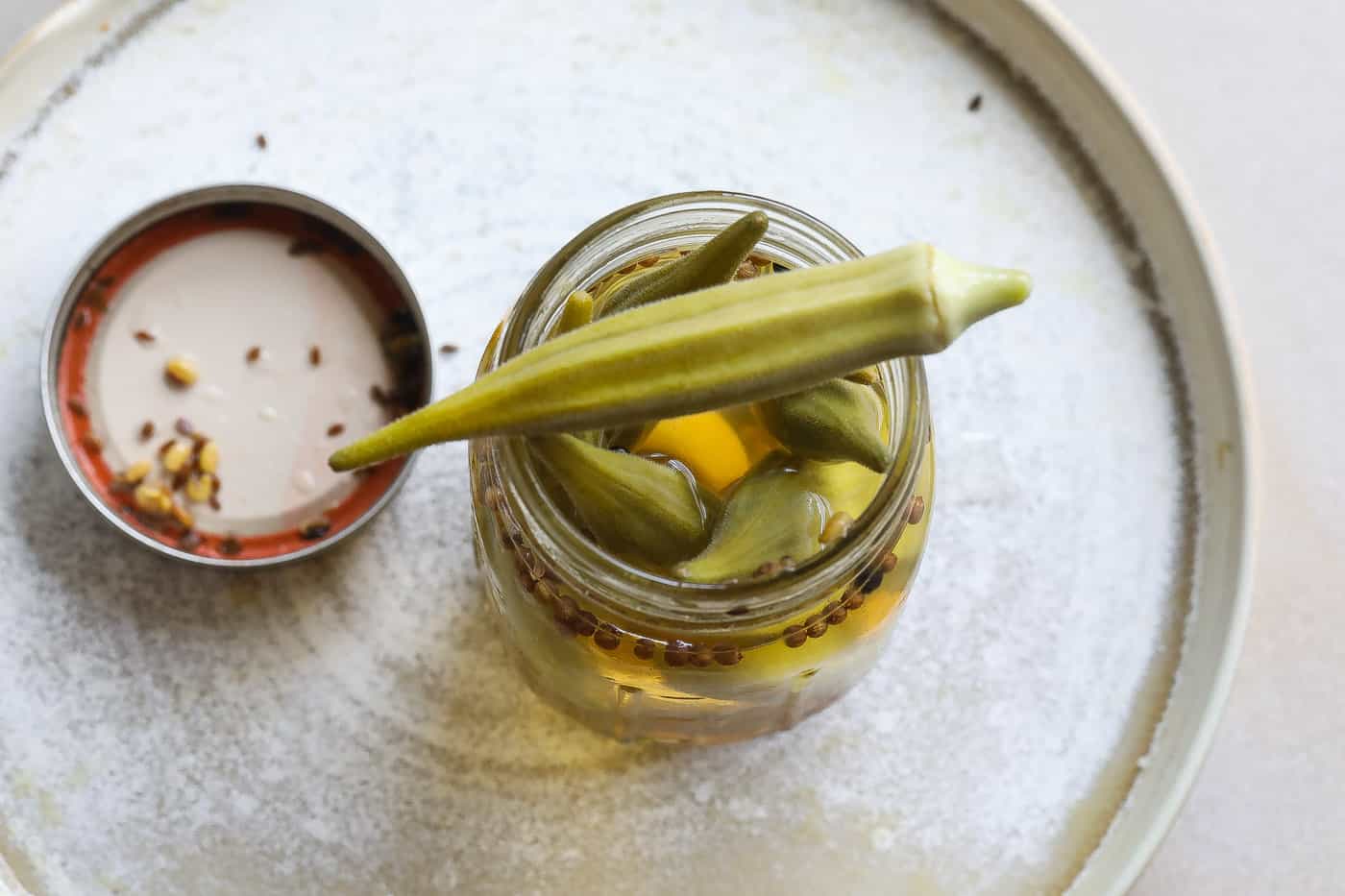This post may contain affiliate links via Amazon's affiliate advertising program. See privacy policy
Of all the vegetables to be pickled, ain’t other like pickled okra. These are crisp, crunchy, and exotic in flavor.
There’s something magical about pickled okra that sets it apart from other pickled vegetables. With its unique texture and tangy flavor, pickled okra is a delightful addition to your pantry staples.
In this post, we’ll take you on a journey through the world of pickled okra, exploring everything from choosing the best okra for pickling to the differences between canning and refrigeration methods, all while sharing our pickled okra recipe.
Whether you’re a seasoned pickling pro, looking to recreate grand mama's magic, or just looking to try something new, our step-by-step guide will give you all the tips and tricks you need to create the perfect pickled okra recipe. So let’s dive in and discover what makes pickled okra so special!
Short Summary
- Discover the unique flavor of pickled okra with two preservation methods, canning or refrigeration.
- Choose young, fresh pods and mix up different pickling spices for your own tasty recipe.
- Follow our step-by-step guide to make delicious pickled okra, plus serving suggestions & troubleshooting tips!
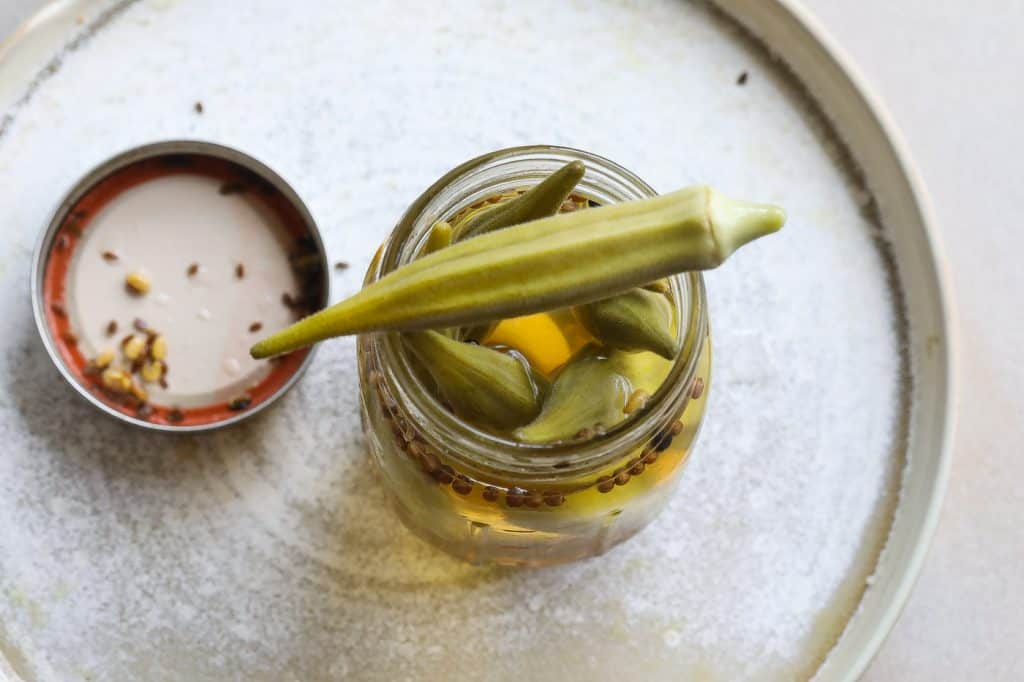
This is a quick refrigerator pickled okra recipe that has a unique flavor due to the spice mix used.
The Magic of Pickled Okra
Pickled okra is a true Southern classic, with a tangy and slightly spicy flavor that’s hard to resist. The key to this unique taste lies in the combination of pickling spices, vinegar, and garlic cloves used in the pickling process. But what sets pickled okra apart from other pickled vegetables is the way the hot brine fills the air pockets inside the okra pod, creating an irresistible texture party in your mouth.
In addition to the fantastic flavor, pickled okra can be preserved using two main methods - canning and refrigeration. Canning involves boiling the jars in a hot water bath, while refrigeration simply means storing the okra pickles in the fridge. Each method has its own advantages and drawbacks, which we’ll explore further in the next sections.
Why Pickle Okra?
Okra, sometimes called “lady’s fingers,” is a versatile green pod vegetable native to Africa. The true magic of okra shines when it’s pickled or even when using frozen okra in various recipes.
So, why pickle okra? The answer lies in its unique structure. The okra pod is hollow on the inside. Seeds inside are soft and cushioned by air pockets. When pickled, these air pockets fill up with the flavorful pickling juice, creating a delightful crunch and tanginess that sets pickled okra apart from other pickled veggies. It’s no wonder that pickled okra has become such a beloved pantry staple!
MOOD MUSIC
Fall is here, but I'm still trying to preserve the summer as much as possible. I'm pickling the remains of my okra harvest.
Pairing pickled okra with Quincy Jones's song "Summer in the City" brings together the tangy, zesty flavors of the pickled okra with the cool and jazzy vibes of the song. The song's smooth melodies and upbeat rhythm create a perfect backdrop for enjoying the refreshing and tangy taste of pickled okra.
As you savor the crispness and unique flavor of the pickled okra, you can immerse yourself in the laid-back atmosphere of "Summer in the City," evoking a sense of relaxation and enjoyment during warm, sunny days. Together, they make for a delightful summer experience that tickles both the taste buds and the soul.
Canning vs. Refrigeration
When it comes to preserving your pickled okra, you have two main options: canning and refrigeration. Canning allows you to store your pickled okra on the shelf without any additional preservatives. This method involves boiling the jars in a hot water bath, which also helps to sterilize them, ensuring that your pickled okra stays fresh and edible. Canned okra pickles can last up to a year, making this method ideal for long-term storage.
On the other hand, the refrigerator method is quicker and easier but has a shorter shelf life. Refrigerated pickled okra will last around one to two months, making it perfect for those who want to enjoy their pickled okra sooner rather than later.
Ultimately, the choice between canning and refrigeration depends on your personal preferences and storage needs.
Choosing the Best Okra for Pickling
To create the perfect pickled okra, it’s essential to start with the right okra. Look for fresh, young pods without any blemishes or soft spots. Varieties such as Louisiana Green Velvet, Perkins Long Pod, and Clemson Spineless are great choices for pickling.
In the next sections, we’ll delve deeper into the importance of size and freshness when selecting okra for pickling.
Size Matters
When it comes to picking okra, size truly matters. Young, tender okra pods measuring 3-4 inches in length are ideal for pickling, as they have fewer seeds and tend to remain crunchier. Larger pods can result in a tougher, more fibrous texture, which is not what you want in your pickled okra.
By selecting the right size of okra, you’ll ensure a delightful crunch that will have you reaching for more.
Where to Find Fresh Okra
Sourcing fresh, high-quality okra is crucial for a successful pickling project. Farmers markets and specialty grocery stores are excellent places to find fresh okra, as they often have a wider variety of produce than regular supermarkets. When selecting okra, opt for firm, bright green pods without any soft spots or discoloration.
Remember, the fresher the okra, the better the flavor and texture of your pickled okra.
Essential Ingredients and Equipment
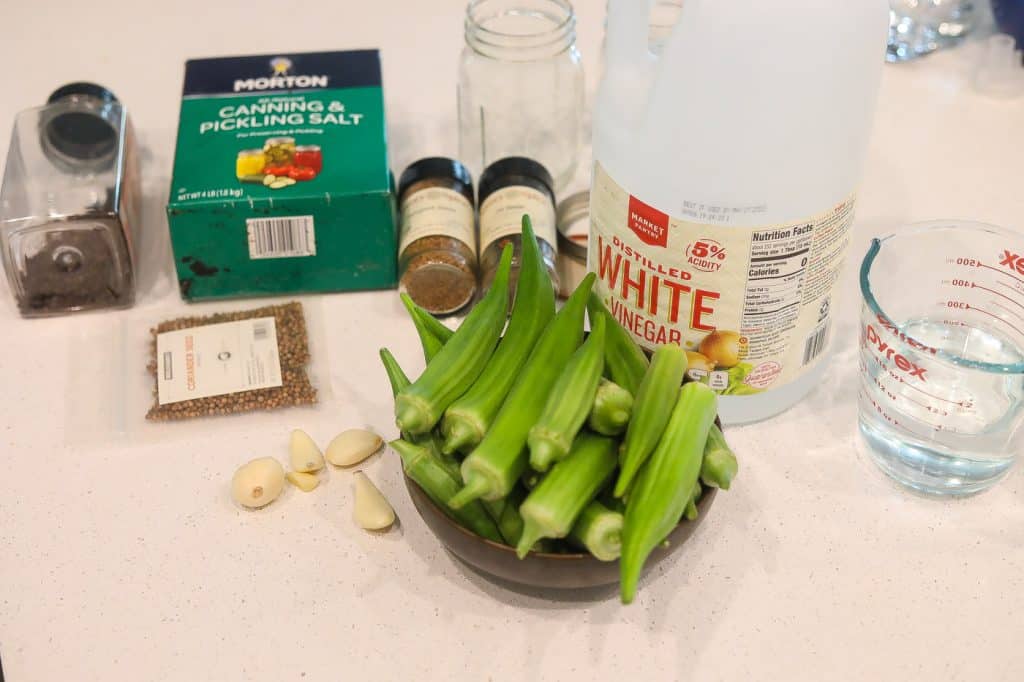
When it comes to pickling, the type of vinegar you use can greatly affect the flavor and texture of the final product. It’s important to choose a vinegar with at least 5% acidity for successful pickling. White vinegar with 5% acidity or higher is a popular choice for pickling okra, but you can also use other vinegars, such as apple cider vinegar or distilled white vinegar.
Now that you’ve got your okra sorted, it’s time to gather the essential ingredients and equipment for pickling. You’ll need okra, pickling spices, vinegar, kosher salt, and jars for this process.
In the following sections, we’ll explore the different pickling spices and vinegar options that can be used to create your perfect pickled okra.
Pickling Spices
The unique flavor of pickled okra comes from the combination of pickling spices used in the process. Common spices include mustard seeds, coriander seeds, dill seeds, and peppercorns. These spices not only contribute to the tangy and slightly spicy flavor of pickled okra, but also help to preserve the vegetable.
Feel free to experiment with different spice combinations to create a pickled okra recipe that’s uniquely yours.
I used the following in my recipe:
- Pickling Salt
- Coriander Seeds
- Peppercorns
- Dill Seeds
- Fenugreek Seeds
- Garlic Cloves
Other spice seed considerations or variations could include fennel seeds, red pepper flakes for a bit of kick, mustard seed, or even hot peppers like jalapenos or habanero.
Vinegar Options
Each vinegar mixture will impart its distinct flavor profile to the pickled okra, so choose wisely!
I used plain white vinegar in my recipe, but feel free to use others (e.g. apple cider vinegar or rice wine vinegar) if you prefer a sweeter or different flavor profile.
Step-by-Step Guide to Making Pickled Okra
With all the ingredients and equipment ready, it’s time to get pickling! In the next sections, we’ll walk you through a step-by-step guide to making pickled okra, from preparing the okra to canning or refrigerating the finished product.
Whether you’re a pickling novice or a seasoned pro, these steps will help you make pickled okra that you’ll love to share with friends and family.
Preparing the Okra
Before you start picking, it’s essential to properly clean and prepare the okra. Rinse the okra well and pat it dry with a clean towel. Carefully use a small paring knife to trim the stems to around ¼ inch. Take caution not to cut through the pods. This will help prevent sliminess and ensure that your pickled okra stays crunchy and delicious.
Once the okra is prepped, you can begin the pickling process. Start by sterilizing.
Creating the Pickling Liquid
To create the perfect pickling liquid for your okra recipe, mix together vinegar, water, spices, and pickling salt in a nonreactive saucepan. A typical ratio is ⅔ vinegar to ⅓ water. Bring the mixture to a boil, reduce heat to medium, and simmer for 30 minutes.
This flavorful pickling liquid, infused with dill seed, will be the key to infusing your okra with that tangy, slightly spicy taste.
Packing the Jars
When it’s time to pack the jars, start by adding a garlic clove or more, dill, and other ingredients to the bottom of each jar. Then tightly pack the okra into the jars, alternating stem-side-up and stem-side-down to ensure a snug fit.
Make sure to leave at least 1 cm of empty headspace at the top of each of the pint jars to allow for expansion during the pickling process.
Canning or Refrigerating
Once the jars are packed, you have two options for preserving your pickled okra: canning or refrigeration. If you choose to can your okra, place the jars in a boiling water bath and boil for 10 minutes. This will ensure proper sealing and sterilization for long-term storage.
If you prefer to refrigerate your pickled okra, simply place the jars in the fridge and allow them to cool before enjoying. No matter which method you choose, your pickled okra will be a delicious and versatile addition to your pantry.
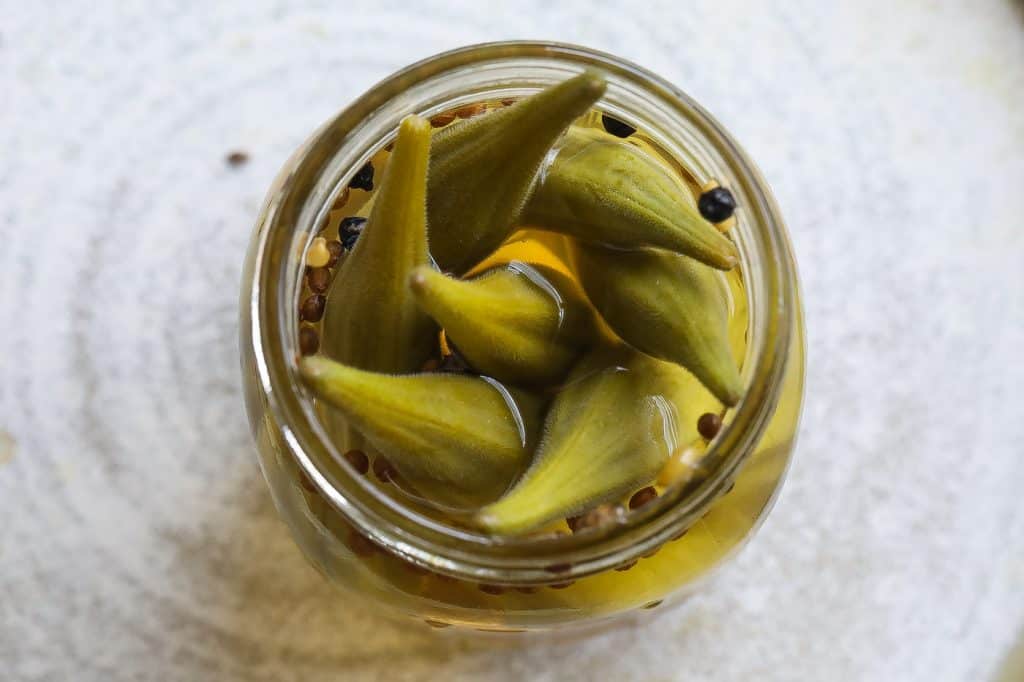
Serving Suggestions and Uses
Pickled okra is incredibly versatile and can be enjoyed in a variety of ways. From pairing ideas to snack options, there are countless ways to incorporate this tasty treat into your meals. For those who love pickled okra, the possibilities are endless.
In the following sections, we’ll explore some of our favorite serving suggestions and uses for pickled okra.
Pairing Ideas
The tangy and slightly spicy flavor of pickled okra pairs wonderfully with roasted meats and vegetables. Try serving pickled okra alongside roasted chicken, pork, beef, or fish, and complementing the dish with roasted potatoes, carrots, and onions.
Pickled okra also makes a fantastic addition to a cheese board, adding a unique flavor and texture that’s sure to impress your guests.
Snack Ideas
Looking for a quick and delicious snack featuring pickled okra? Try pickled okra rolls for a low-carb option, or serve pickled okra with cheese or in a Bloody Mary for a fun twist on a classic cocktail. Pickled okra also makes a great addition to a cheese board or charcuterie platter, adding an extra layer of flavor and texture that’s sure to please.
Whether you’re looking for a snack to munch on or a unique addition to your snack.
Troubleshooting Common Issues
As with any pickling project, you may encounter some common issues along the way. From sliminess to cloudy brine, we’ve got you covered with expert tips and tricks to help you troubleshoot and perfect your pickled okra.
In the next sections, we’ll address these issues and offer solutions to ensure your pickled okra turns out just as you envisioned.
Preventing Sliminess
No one likes slimy pickled okra, so it’s important to take steps to prevent this issue. To avoid sliminess, soak your okra in vinegar for 30 minutes before picking or cooking. This simple trick will help to eliminate the mucilage that can cause sliminess and ensure that your pickled okra remains crunchy and delicious.
Clearing Cloudy Brine
Cloudy brine can be an unsightly issue during the pickling process, but it’s generally safe to consume. To clear up cloudy brine, simply strain it and add some fresh vinegar to the mixture. This will help to eliminate any impurities and restore the clarity of your pickling liquid, resulting in a more visually appealing finished product.
Ensuring Tender Texture
To ensure a tender texture in your pickled okra, it’s crucial to select the right size of okra and properly prepare it for pickling. As mentioned earlier, young, tender okra pods measuring 3-4 inches in length are ideal for pickling.
Additionally, bringing the water to a rolling boil and boiling the okra for 2 minutes before pickling can help to soften the pods and create a more enjoyable texture.
Summary
In conclusion, pickled okra is a delicious and versatile addition to your pantry staples. With its unique flavor and texture, it’s sure to become a favorite among your friends and family. By carefully selecting the right okra, using the proper pickling spices and vinegar, and following our step-by-step guide, you’ll be well on your way to creating the perfect pickled okra.
Whether you choose to can or refrigerate your pickled okra, the possibilities for serving and enjoying this Southern classic are endless. From pairing ideas to snack options, pickled okra is a delightful treat that’s sure to please. So go ahead, give pickled okra a try, and discover the magic that awaits in every bite.
Frequently Asked Questions
How long does it take for pickled okra to be ready to eat?
Pickled okra is ready to eat in just a few days, so be sure to give it 1-2 weeks for the flavors to fully develop before digging in!
The longer you let it sit, the more flavorful it will become. Enjoy!
How do you keep pickled okra from being slimy?
Keeping okra from being slimy is as simple as soaking it in acidic vinegar to counteract its natural pH levels. Doing so creates a crunchy and flavorful snack, perfect for pickling.
What is the shelf life of pickled okra?
Pickled okra has a shelf life of up to one year when stored in a cool, dark location.
Refrigerated pickled okra will last 1-2 months and should always be handled with clean utensils.
What's the best size of okra for pickling?
For pickling, go for okra pods that are 3-4 inches long and young and tender.
ADDITIONAL PICKLING CONSIDERATIONS AND TIPS
Most recipes call for sterilization, but for these it’s not a requirement since these are meant to be eaten fairly soon vs. canning them for months.
Make sure you eat within 4 weeks, unless you follow normal sterilization steps.
For these I also skipped the sugar add as well as boiling the brine. I like my pickled okra “briny” or “pickly” vs sweeter taste profiles many recipes lean towards. Pretty much every recipe calls for boiling. I used to always boil until I forgot to once and ended up with cleaner tasting and crispier okra. I haven’t looked back sense. I’m sure I’m breaking some fundamental culinary code, but oh well.
I prefer whole spices to ground ones. Whole ones give you the flavor minus the cloudiness and powdery consistency.
Don’t trip if you don’t have pickling or canning salt on hand or can’t find it at your local grocery store. Kosher salt works just fine in pickling recipes. Pickling and Kosher are the only salt types to consider though. They are made with fine granules which. Makes for easy dissolving. The other advantage is these types aren’t likely to contain additives.
Leave the okra whole and just be patient. Halved or quartered okra pickle faster but it’s a different eating experience that is less optimal.
Checkout my okra guide for different ways to use okra in recipes.
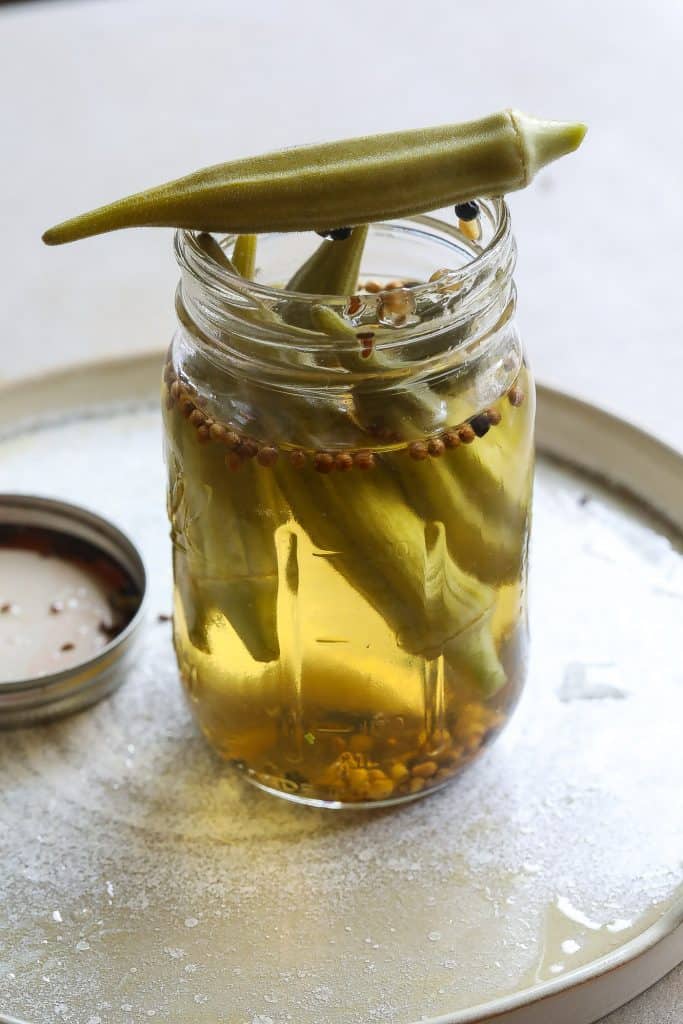
MORE OKRA RECIPES
make this recipe
Pickled okra is a mainstay in a soul food kitchen. If you make this refrigerator pickled okra recipe, please come back and leave me a comment below with your feedback. Definitely take a photo of the dish and be sure to tag #foodfidelity so that I can see them.
You can also keep up with my food exploits as well as original recipes! You can find me on Instagram, Facebook, Twitter, and Pinterest. If you like any of the music you find on the site, visit me at Spotify to find curated monthly playlists.
Lastly, go to my YouTube channel and subscribe to be notified when new weekly videos are uploaded.
Ingredients
- ¾ lb Okra
- 1 teaspoon Dill seed
- 1 teaspoon Fenugreek seed
- 1 teaspoon coriander seed
- ½ tablespoon Peppercorn
- 2 tablespoon Canning salt
- 1 cup White vinegar
- 1 cup Water
Instructions
- Place all spices in glass jar. Stuff the okra pods into the jar as tight and snug as you can get them.
- Add garlic, water, and vinegar to the jar, close with lid and shake until salt dissolves fully. Refrigerate for at least 3-4 days before consuming.
Video


